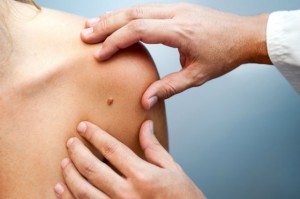
The statistics are a bit frightening – skin cancer afflicts over two million people every year, and that number is said to be increasing rapidly, according to The Skin Cancer Foundation. It’s also been estimated that 40-50 percent of fair-skinned people who live to be 65 will develop at least one skin cancer over their lifetime.
While everyone has moles on their skin, a small percentage can be abnormal or atypical moles that can develop into melanoma over time. They can appear anywhere on the body, though most moles appear by the age of 20.
Your pattern of moles is believed to be determined by genetics, but sun exposure can cause you to have more, or cause the ones you have to become darker. A normal mole can appear flat or raised, or may begin flat and become raised over time. Its surface is typically smooth, round or oval and no larger than a pencil eraser.
Redheads, blue-eyed blondes and those with pigment disorders like albinism are at the greatest risk of developing skin cancer. Latinas who have fair skin and light-colored eyes are also susceptible to melanomas because they were born with less protective melanin in their skin.
No matter what your risk category, it’s important to regularly examine your skin to look for signs of new moles as well as changes in the moles you already have. Self-examinations can alert you to changes in your skin and help you detect problems early.
If you have a family history of atypical moles or skin cancer, or a large number of moles or freckles, your physician may suggest that you see a dermatologist on a regular basis for skin evaluations.
If you notice any of the following, be sure to consult your doctor:
- An asymmetric mole, meaning one in which one half of the mole doesn’t look like the other.
- A mole with a poorly defined or scalloped border.
- A mole that has various hues, including multiple shades of black, brown, white, red and/or blue.
- If a mole has a diameter larger than a pencil eraser
- If a mole changes shape, size or color over time
- New moles that develop after the age of 20
- Any mole that is painful, bleeds or itches
 Keep in mind that most moles are harmless. If you have one that looks suspicious, it can be easily removed with little pain and sent to a lab to confirm that it is not cancerous. If it does happen to be melanoma, getting suspicious moles checked as early as possible will allow your doctor to detect skin cancer in its earliest stages, when it’s the most treatable.
Keep in mind that most moles are harmless. If you have one that looks suspicious, it can be easily removed with little pain and sent to a lab to confirm that it is not cancerous. If it does happen to be melanoma, getting suspicious moles checked as early as possible will allow your doctor to detect skin cancer in its earliest stages, when it’s the most treatable.
-The Alternative Daily
Sources:
http://www.skincancer.org/skin-cancer-information/skin-cancer-facts
http://mamiverse.com/is-that-mole-dangerous-the-truth-about-detecting-skin-cancer-4053
http://www.everydayhealth.com/skin-and-beauty/skin-conditions/tips/mole-or-skin-cancer.aspx

